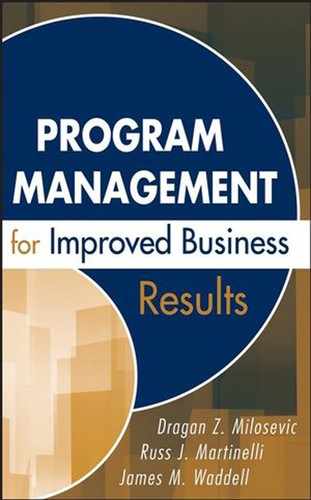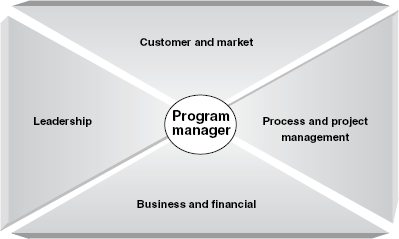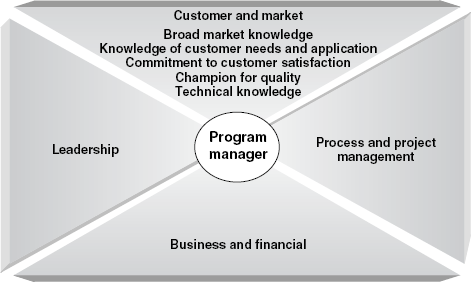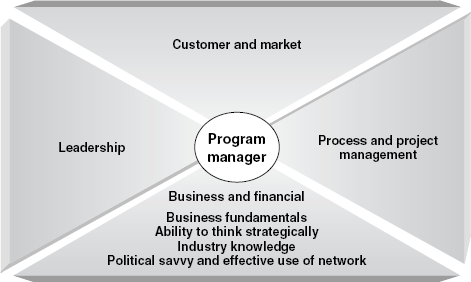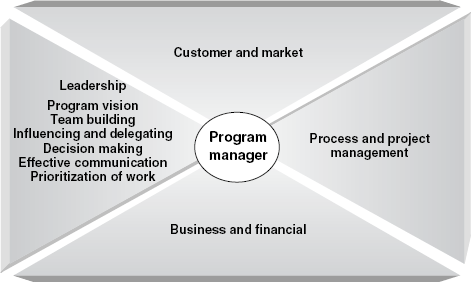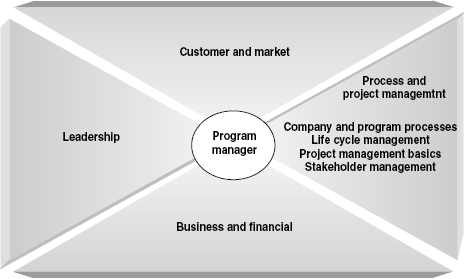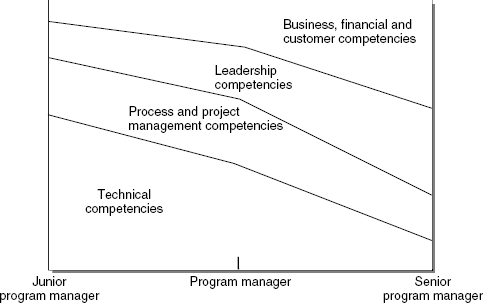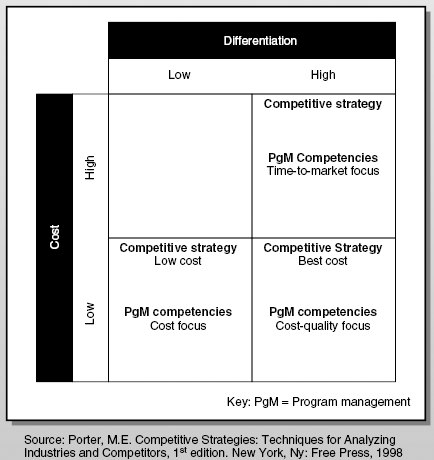What was your motivation for choosing the program management model for developing products? We posed that question to Gary Rosen, vice president of engineering for Varian Semiconductor Equipment. Rosen responded by stating the following:
When observing the differences between poorly-run product development efforts and well-run efforts, I noticed the difference was that the well-run programs had a true program manager in charge. These people had a broad skill base that is needed in the capital equipment industry—good people skills, good business acumen, and good system (integration) skills. Unfortunately, not a lot of people have these broad skills.
It is a rare program manager that comes to the role totally qualified to fulfill all aspects of such a broad and encompassing set of skills and competencies. The successful program manager is constantly seeking to learn and broaden his or her knowledge and experience to take on more complex and critical programs. Senior management, in turn, needs to create a positive learning environment to encourage program managers to continually seek improvement and growth.
We developed the program management competency model, which addresses the breadth, depth, and complexity of the program management role. This model provides senior management with an excellent aid for developing program management as a true discipline that can provide competitive advantage through business efficiency. As the capability and experience of program managers grows, the greater the probability that they will successfully deliver the business objectives of the firm. The competency model is an excellent career development guide for program managers, project managers, and others aspiring to become program managers.
In this chapter we use the program management competency model to detail the knowledge, skills, and abilities needed for an experienced program manager to successfully perform his or her function. Additionally, we discuss the key organizational enablers needed to make the competency model fully effective and to adequately support the program management discipline. Finally, we show how the model can be customized to meet company needs. The purpose of this chapter is also to assist all members of an organization to understand the following:
The core competencies that are needed for the experienced and successful program manager.
Key organizational enablers that, if in place, assist the program manager in execution of his or her core competencies.
The value of the competency set to the individual and the organization in pursuit of continual improvement for enhancing individual performance.
The use of the program management competency model as a tool for career growth and performance evaluation of the program manager.
The program management competency model has been designed to provide the necessary knowledge, skills, and organizational enablers to systematically support the recruiting, staffing, professional development and career planning of the program manager (see box titled, "What is Competence?"). The information presented in this section is derived from companies that utilize program management as a true discipline and critical business function. These companies have devised comprehensive training and development approaches to support this key role. Although the technical aspects of product, service, and infrastructure development are critically important, much of the success of a program is behavioral and human-oriented in nature. Program management truly meets the traditional management attribute of getting things done through other people.
The program management competency model details the areas in which the program manager should gain proficiency to help the organization achieve expected business results. As mentioned, the model identifies the knowledge and competencies critical to success in performing the role of a program manager. The model also includes what we characterize as key enablers. Enablers are things that create or proactively encourage a positive environment to provide the maximum opportunity for success, learning, and growth to occur in program management. Enablers range from environmental factors to organizational and managerial culture, philosophy, and actions. Examples of some general enablers would include an organizational structure with clear roles and responsibilities defined for those involved in product, service, or infrastructure development and stable systems that can accurately and consistently measure program status and results.
The objective of the model is to provide a comprehensive set of competency criteria that can be used for the continued development and career growth of program managers. It also should be noted that each of the four competency areas includes its own specific technical competencies and tools related to its function. The term technical applies to the critical knowledge and tools necessary to become proficient in a particular discipline. Technical problems that occur within a program are not the direct responsibility of the program manager. These types of problems will normally originate within one of the functional disciplines, such as engineering. They should be addressed and solved by the project managers and the technical specialists of each functional discipline represented on the team. When, and if, a problem is not appropriately resolved by the functional team, it becomes a barrier to the program's objectives. The program manager must then intervene to ensure that the appropriate focus and resources are applied to the issue to reach closure.
Figure 13.1 illustrates the four competency areas in which the program manager must become proficient.
One aspect from the summary view of the core competency model is that project management is but one element of the program management discipline. This underscores the discussion in Chapter 1 that showed the distinction between program management and project management. One can visualize from Figure 13.1 that program management is a broader role than project management. For this reason, project management certification is helpful for the practicing project manager but is insufficient for the program management role. In addition to strong project management competencies, the successful program manager needs to gain proficiency in business, market, and leadership. Without this added proficiency, the transition from a project management role to a program management role is many times frustrating for the individual, the organization, and the customer.
Figure 13.2 illustrates the areas in which the program manager should gain proficiency within the customer and market core competency.
Customer and market competency means that the program manager has a full understanding of the market or organization that the product, service, or infrastructure capability is being deployed into and knows how it will be used by the customer and end user. This is important because the program manager and his or her team can closely align the product, service, or infrastructure capability with the customer's needs in a more efficient way. It will also enhance the potential for customer satisfaction and the successful achievement of the business results intended. Specifically, there are several technical competencies that the program manager should become adept at, including knowledge of their company's products, services, and infrastructure capabilities and key applications. Generally, the program manager should possess a working knowledge of the key technologies that a firm's products, services, or infrastructure capabilities are based upon, as well as the future technological trends within their industry.
As a part of a firm's development approach today, it is common to have key customers participate in the development process. Therefore, the program manager should be knowledgeable and sufficiently skilled to incorporate the valuable input of the customer into the design and development process—what some call customer intimacy. The program manager should be able to demonstrate a commitment to the customer, demonstrate knowledge of customer application and needs, and be able to apply market and customer validation and assessment tools (see box titled, "Do You Know What Your Customers Really Want?"). In addition, as the quality champion, the program manager should possess a bias for action; be able to think globally; and assure that quality, reliability, manufacturability, serviceability, and regulatory compliance targets are achieved.
Key organizational enablers that support the program manager in the customer and market competency area include the following items: (1) Adequate funding provided by the company for thorough market research to identify such things as market segmentation, customer demography, market trends, and competitive positioning; (2) the development of good voice of the customer programs on the front and back ends of the program to help identify customer needs and customer satisfaction respectively; and (3) getting the customer involved in the product, service, or infrastructure development and validation processes to ensure the program output satisfies customer and market needs.
Business competencies include the ability to develop a comprehensive program business case that supports the company's objectives and strategies; the ability to manage the program within the business aspects of the company; and the ability to understand and analyze the related financial measures pertaining to the product, service, or infrastructure capability under development. As we detailed in Chapter 12, managing the business aspects of the program is a primary role of the program manager. The areas in which the program manager should gain proficiency to effectively manage the business elements of a program are shown in Figure 13.3.
First and foremost, the program manager needs to have a working knowledge and level of proficiency in business fundamentals. As we've stated multiple times, program management is about the business. Business fundamentals include capabilities in financial analysis and accounting, international management, economics, law and ethics, resource management, negotiation and communication, and management of intellectual property.
The program manager is required to think strategically to align the program, and the projects within the program, to the strategic objectives of the organization. A part of strategic thinking involves a basic understanding of the industry in which the business operates. Industry trends, knowledge about competitors, and supply chain implications are a fundamental part of keeping a program viable from a business perspective. The program manager should possess a strong business sense and integrative capability to successfully manage the broad array of strategic, business, and financial attributes related to his or her specific program.
It is important that the program manager possess both a keen understanding of the organization and is politically savvy to build strong relationships. Company politics are a natural part of any organization, and the program manager should understand that politics is a behavioral aspect of program management that he or she must contend with to succeed. The most effective method for playing the political game is to leverage the powerful members of one's network who can help achieve the program objectives.[151] The key is to not be naïve and understand that not every program stakeholder sees great value in the program. A program manager must be sensitive to the interests of the most powerful stakeholders, and at the same time, demonstrate good judgement by acting with integrity.
Organizational and cultural enablers should be in place to assist the program manager in successfully achieving the business and financial competencies. Long-term vision and strategic direction, which is identified by business management, should have a proper balance between short- and long-term objectives. Additionally, a strong correlation between senior management's words and actions will build credibility across the organization and, specifically, with the program team. An effective portfolio management process helps to prioritize and select programs that best align to the long-term vision and strategy of the business. This establishes a balance between resource capacity and demand. Lastly, robust and stable financial systems need to be in place to accurately measure program progress and results.
Leadership competencies are how we describe the "people skills" that program managers need to be successful in leading a team of people and managing a set of stakeholders. Leadership competencies involve those that are needed to effectively lead multiple cross-disciplined project teams that are a part of the program. Specifically, we are referring to organizational leadership competencies. The ability to lead the cross-project and cross-discipline teams is a key role of the program manager, as discussed in Chapter 12. The program manager needs to have the capability to build, coalesce, and champion the team to achieve product, service, and infrastructure solutions that will satisfy the company's customers. The areas in which the program manager should gain leadership proficiency to effectively lead the program team are shown in Figure 13.4.
Strong leadership begins with the ability to create and continually champion the program vision. If a program manager expects the program team to follow him or her through all phases of the PLC, he or she needs to explain how the team's hard work and dedication contribute to the broader vision of the program and company. People need to understand how their work contributes to the success of the business.
The second aspect of the leadership core competency is team building. The program manager should be able to build a team that will meet the program objectives; create an environment of trust and respect; demonstrate value in diversity of people, styles, and opinions; acknowledge and recognize team member accomplishments; resolve conflicts and differences; and act as a coach and mentor to junior members of the team. Today's business models have created additional team building challenges for program managers, as discussed in the example titled, "Virtual, Discontinuous, and Condensed Team Building."
The ability of the program manager to achieve the firm's objectives lies with his or her expertise, background, and competencies to lead and accept accountability for the entire team's effort and resulting outcome. To effectively lead the team, the program manager needs to be respected by senior management and the members of the team. This requires personal characteristics that include credibility, integrity, and responsibility.
In contemporary program management, members of the program team seldom report directly to the program manager. This requires that the program manager become proficient in influencing the actions of the team. Influencing competencies are also required to positively affect the actions and decisions on the part of the senior management team, key partners, suppliers, and support organizations. Successful program managers also are adept at the skill of conflict management and resolution. Conflict can, of course, occur at all levels of the program and between the program team and other groups within the firm. Anticipating these types of problems and being able to properly and objectively address and finesse them is one of the most important abilities of an excellent program manager.
Just as the program manager must be empowered by the senior leaders of the business, the program manager must be willing to empower the project managers on the program. This means being willing to delegate authority and responsibility. To effectively manage horizontally, or across the project teams, the program manager cannot spend an inordinate amount of time or effort working with any one project team (see Chapter 1). He or she must set clear expectations of each project team and then allow the project managers to execute and deliver on the expectations.
The program manager's ability to set and balance program priorities is one of the key indicators of success. The first step in setting priorities is checking to make sure the program priorities are correct. It is one thing for a program manager to set the program priorities, but it is most important to validate the priorities with the primary sponsors of the program. The most critical aspect of the priority validation process involves testing the assumptions driving the program priorities with the program sponsors. If the assumptions behind the priorities are incorrect, it's quite possible the priorities themselves will be incorrect. Once the priorities are validated, the program manager should manage accordingly. For example, if cost containment is the highest priority of the program, then the program manager must emphasize the need to stay within the financial constraints of each project and the program as a whole. If technological leadership is the highest priority, the program manager will need to keep the project teams focused on the technical aspects of the program and provide the necessary resources to ensure technological success.
The success of the program manager's ability to make timely decisions will be considerably influenced by their degree of experience, knowledge acquired, and their ability to think of the program from a holistic perspective. Making good, timely decisions is a critical factor in achieving time-to-money goals. There can be thousands of decisions, large and small, that a program manager will encounter during the course of a program. To prevent even a small number of these decisions from being barriers to progress, a program manager needs to be proficient in collecting all necessary facts, analyzing the pertinent data, and then driving to a decision. Nothing can be more frustrating and paralyzing to a program team than waiting for a decision that gates progress.
Program decisions need to be aligned with the strategic direction of the program and the strategic objectives of the business; therefore, the decisions should be approached from a holistic perspective.[152] Losing sight of the strategic reasons for a program, while making the series of large and small decisions during the course of a program, is a primary reason why some programs become misaligned with the strategic objectives of the business. Likewise, decisions made on the program can also have an effect on the profitability of the business. Many times, decisions that a program manager makes during the program have the most important consequences after a product, service, or infrastructure capability is delivered. For example, a decision to add a new feature to a product may affect the gross margin in a couple ways. The added feature may allow the company to increase the price of each product sold, therefore, positively affecting the gross margin. However, the additional feature may change the physical configuration of the product. This may increase the manufacturing cost of each product, therefore, increasing the cost of goods sold and negatively affecting the gross margin. The ability of the program manager to make program decisions with all business consequences in mind is a critical skill within the leadership core competency.
Communication is another critical leadership competency in which the program manager should foster open communication across all functional elements and throughout all levels of the organization. This requires the ability to speak multiple disciplinary languages—business language when communicating with senior management, user language when communicating with the customer, technology language when communicating with technologists, and so on. Effective communication competencies also mean that the program manager should be able to actively listen and provide clarity in difficult situations, many times serving as the translator in multidisciplinary discussions.
A senior program manager we talked with told us the story of why the second program he managed was a major failure (his first program was very successful).
Because of the success I had with my first program, I thought I knew all the answers on the second program and stopped listening to what was being said to me by the program team. I listened to what I wanted to hear versus what they were really telling me. I wasn't looking for problems, even though they were being communicated to me by my team. Eventually, the problems became insurmountable and I was removed from the program manager position.
Finally, effective program managers are continually prioritizing their work and the work of their team to achieve the greatest return from the actions of the team.[153] There is an enormous opportunity for the program team to spend too much time on work that is of little value, which is due to the complexity and scale of many programs. The ability of the program manager to focus the work of the project teams on the highest priority needs of the program, for example the next set of deliverables due, is crucial for maintaining a high level of team productivity. The effective program manager is continually sharing the program vision and the next set of targets to hit to keep the work of the project teams focused on the priorities of the program.
Several enablers should be in place to assist the program manager in successfully developing and utilizing the leadership core competencies. A stable organizational structure with clearly defined roles and responsibilities establishes the foundation for good leadership. The program manager must be empowered by senior management, with an established balance between responsibility, authority, and accountability to effectively lead the program team. A well-defined decision structure and program governance plan should be in place to facilitate time-to-decision performance. Finally, a consistently visible and active senior management team is needed. Senior managers must understand and be willing to perform their role on the program on a consistent and continual basis.
The program manager should be well versed in core program processes and project management competencies and be able to abstract the competences for use at the program management level. The program manager needs to be competent in program processes to handle program-level issues. Also, both the program manager and the functional project managers on the PCT must possess operational competencies, including project management methods and tools, to effectively manage the tactical elements of the program. The areas in which the program manager should gain process and project management proficiency are shown in Figure 13.5.
Another important aspect of this core discipline set is the program manager becoming proficient at possessing a solid working knowledge of the specific processes and practices of the company. If he or she knows how things get done, the policies and procedures that must be adhered to, and understands who must be involved and approve various aspects of the program, the manager will increase the likelihood of successfully completing a program. If it is a product-based company, for example, the program manager must be thoroughly familiar with the firm's new product design, development, and market launch processes to ensure that the development team's efforts adhere to management's requirements and expectations as to how products must be designed and built. The program manager who develops this competency will increase his or her probability of gaining team member's confidence and trust. They will become confident that their leader knows how to get things done in a timely and successful manner.
Project management basics are best described and represented in the Project Management Institute's (PMI) PMBOk. This reference guide presents nine knowledge areas for the effective management of projects:[154]
Integration management
Scope management
Time management
Cost management
Quality management
Human resources management
Communications Management
Risk management
Procurement management
The PMBOK provides key information and understanding that both project managers and program managers should master to possess the highest probability of success in achieving the objectives and expectations of their customers and management. When it comes to project management competencies, the program manager's role is similar, with the key added dimension of integrating and coordinating the work being done on two or more projects simultaneously within a program.
In addition to the knowledge areas called out in the PMBOK, stakeholder management is a critical competency that needs to be called out separately. The program manager can have many stakeholders that he or she has to manage both internally and externally (see the box titled, "Even a Salad Vendor May Be a Stakeholder"). In some cases, stakeholder management can become a full-time job in and of itself, if not performed effectively. Good stakeholder management involves understanding who the program stakeholders are and their needs, the level of influence each stakeholder has on the program, and their allegiance and attitude toward the program (never assume all stakeholders want the program to succeed). From this information, the program manager can determine which stakeholders he or she needs to manage and how to manage them (see Chapter 8). Effective stakeholder management helps the program manager gain cooperation from the highly influential stakeholders, cut through competing stakeholder agendas, and confront those who may be inhibiting program progress.
Key company and industry enablers should be in place to assist the program manager in successfully performing the process and project management competencies. The firm should encourage the connection of their program and project managers to professional organizations to enhance and broaden their learning experience. It is helpful for career development if senior management assists in funding personal skill and knowledge development. It is also helpful if a firm views program management as a functional discipline and provides and encourages ongoing development of personnel in this skill category. Additionally, some firms require basic skill certification in project management as an entry-level requirement for employment as a project manager.
Each company should adapt the mix of competency groups in the described model and tailor it according to its needs and level of program complexity. Specifically, in the descending order of complexity, companies do breakthrough programs (yielding products, services, and infrastructure capabilities that are new to the world) platform programs (yielding multiple configurations); and derivative programs (yielding products, services, or infrastructure capabilities derived from the platform products). Each of these program types is of different complexity and requires program managers of different maturity and competency levels.
For example, as demonstrated in Figure 13.6, junior program managers typically have higher levels of technical competency and lower levels of business and leadership. This is mainly because junior program managers are commonly promoted from a technical function or the project management ranks to lead a program. They have not yet had time or experience leading larger, more business significant programs to hone their leadership competencies.
In contrast, senior program managers who lead larger and more significant breakthrough and platform programs have typically not been involved in solving specific technical problems for a period of time; therefore, they are unable to maintain their technical competency. Rather, long exposure to business, financial, and customer affairs help the managers polish these broad-based competencies. Similarly, managers with years of experience, who lead cross-discipline program teams, have the opportunity to polish their business, financial, and leadership competencies.
Generally, direct technical skills become less important as the program manager takes on larger, more complex programs. He or she then delegates management of the technical aspects of the program to the project managers but may intervene on a technical issue, if it becomes a barrier to the success of the program. The need for business, financial, market, and leadership competencies grows as program managers face more complex and strategically important programs.
Process and project management competencies are somewhat different. Junior program managers have modest competencies of this type because they normally have project management experience within the company prior to taking on program management assignments. As their maturity and experience grows in the program management discipline, process and project management competencies become less significant, and more focus is applied to the business management and team leadership aspects of program management.
Understanding and managing the program management competencies and mix of maturities is important but insufficient by itself. A company utilizing the program management discipline to develop products, services, and infrastructure capabilities should also align program management competencies to the business strategy for maximum effectiveness. As discussed, companies select a business strategy as a means of competing with their rivals in the market place. Although each type of business strategy has the same goal to create competitive advantage, ways to accomplish the goal differ. For example, one company may choose to build competitive advantage by using a strategy to be the low-cost leader within an industry, while another company within the same industry may choose a strategy of technical differentiation.
The business strategy of a company should then drive the particular competencies that are necessary. For example, a program manager within a company employing a low-cost strategy will need to develop competencies that focus on cost first and foremost. This requires customization of the program management competency model to emphasize cost-based skills and abilities within the four competency categories. The box, "Customizing Competencies in the Projector Industry," provides an in-depth example of how program management competencies are tailored to align to a company's business strategy.
We would be remiss if we did not address the subject of a program manager managing multiple, simultaneous programs. This is relatively common when a company has a number of smaller programs occurring at the same time. It is not unusual for a program manager to manage two to four smaller programs concurrently. It is our point of view that managing multiple, smaller programs simultaneously is not a unique competency but rather a matter of experience and proficiency gained in the program management core competencies. As program managers become more proficient in their core competencies, their skills become scalable, which allows them to manage larger, more complex programs and multiple programs.
Staffing of program managers within the organization is a key exercise of capacity loading for the number and complexity of programs that the firm plans to manage over a given period of time. The importance of doing an excellent job of staffing is obvious—the ability to select the best candidate for the role will enhance the organization's ability to succeed in their development objectives. Once the staffing needs have been determined, the organization can fill these positions either from external new hires or by selecting individuals within the firm who possess the potential to grow into fully qualified program managers. The latter approach assumes that at least a portion of the firm's existing program managers are appropriately trained and sufficiently experienced to provide coaching and mentoring to any new internal candidates.
Selection of individuals should be measured against established job descriptions that characterize the specific role needed for the firm; the key responsibilities; and the required skills, abilities, and qualifications of the position. The job description will serve as the basis for establishing the screening, selection, and hiring criteria. Assuming the firm has multiple levels of program management experience identified, job descriptions should be tailored to fit each position. These positions may range from an entry-level program manager who manages smaller, less complex development efforts to a senior program manager who manages large, complex, and multisite development programs.
Once the program manager job description has been approved and implemented, it can serve as the basis for individual performance evaluation. The job description, the program management competency model, and expectations by management will serve as the basis for determining and documenting the accomplishments and overall performance of the individual. Performance evaluation, if done correctly, can provide recognition for good performance, increase personal motivation, and identify course corrections needed for performance misses. The performance evaluation, coupled with training and development, become powerful tools for driving continual improvement in program management practices within an organization.
The knowledge, skills, and abilities described as part of the program management competency model are most useful for growing and developing the firm's program managers, once they are hired. This is important because future gains are made through a model of continual improvement in performance. Business competition has proven that if you are at status quo, others will pass you by. Systematic training and development will increase the probability of staying ahead of the competition. Of course, much of what the program managers will learn will come from the on-the-job training while running their specific programs. However, to further broaden their capabilities and achieve the potential of the individual, it is helpful if senior management provides encouragement for continual improvement in their discipline.
Many program managers are in their disciplines because they enjoy the role and want to make it their career. Most highly effective program managers are self-motivated and demonstrate a desire to self-assess, take on a philosophy of continued improvement in their growth and responsibility, and are persistent in attainment of their personal objectives. In doing so, they may pursue growth and advancement opportunities within their company, which is important for the long-term viability of the firm. In many firms, the role of program management is viewed as a career path to business management. This is because much of the program management role embraces and overlaps the competencies associated with business and general management.
As stated earlier, it is rare that program managers come into the role fully proficient in all core-competency areas (see box titled, "How Many Skills are Required?"). The program management competency model has been used by some companies as the guideline for continual career development of their program managers. Ongoing dialog between the individual program manager and his or her direct manager are focused on understanding the program manager's growth and career aspirations and balancing that with management's short- and long-term performance expectations. The results from this exercise serves as the basis for an individual development plan over a given period of time (annually in most cases) for the program manager. It is a process of targeting where the individual currently is in their performance and capability, where they want to be in their career and performance at some time in the future, and then laying out a plan of development on how to get there. The specifics of the plan may include some or all of the following:
Internal training courses: Some firms offer their own structured training modules for the program manager. These may be web-based and available to the entire population of the company regardless of location.
External training seminars and courses: Many professional organizations and consulting firms offer a variety of courses. However, good courses focused on program management are few and difficult to find.
College-degree programs: There are currently no degree programs offered in program management. However, some Masters of Business Administration degrees are valuable for providing the broad core competencies needed by a program manager.
Industry certifications: At the time of this writing, there are no program management certifications currently offered outside of the U.S. defense industry, and project management certifications are insufficient for program management. However, some companies have instituted their own internal certification.
Specific assignments for on-the-job training and experience: This is an effective technique for broadening the experience and capability of a program manager.
Rotational assignments through various organizations within the firm: If the firm views program management as a career path to broader and larger roles in the firm (such as general management), this is a useful way to evaluate the potential of the individual.
Mentoring relationships: Newer program managers can gain much knowledge and capability enhancement by mentoring from an experienced program manager.
If the program management model is embraced by a company, then growing and nurturing it's program management personnel not only enhances performance but also provides greater individual advancement opportunities and the ability to grow talent within the firm for the future. According to Steven Wheelwright and Kim Clark, authors of "Revolutionizing Product Development", it is essential that managers give attention to issues of career paths, education and training and, in general, the development of human resources in the organization.[155] If a company does not provide an established career path for the program manager, then a program manager's best chance for advancement within his or her discipline may be pursuing more senior-level positions in other companies or industries.
As mentioned earlier in this chapter, there are certain management philosophic and cultural considerations that bear on the ability to advance the program management discipline within the firm, as follows:
- Strategic importance of program management to the firm:
Firms that see the strategic importance and value that the program manager brings to the business are more motivated to invest in the growth of the function for the future. These firms are willing to fund personal skill and knowledge development for program management personnel.
- Viewing program management as a discipline:
Program management needs to be recognized as a professional discipline and managed as a function within the company. Organizations are much more inclined to recognize the need to fund development of competencies within the formal functional disciplines of the company. Having program management recognized as a function and a professional discipline, which is lead by a senior manager or director of program management increases the probability that senior management will fund its skill and development needs.
- Formalized professional development planning:
A formal approach to professional development contributes to an environment of continual improvement of the firm's employees. If the company formally looks at individual performance jointly between the employee and their manager and finds ways to improve performance for the future, it will naturally lead one to see the value of improving the competencies and capabilities of the employee.
- Training philosophy:
Larger firms are more capable of providing internal training and development resources and fund external opportunities for their employees than smaller firms. However, it also depends on the philosophy and management view about the value of training and development. Some senior managers are much more inclined to view training and development as an important weapon in their arsenal to stay competitive. These managers foster a philosophy of continual professional development of their employees and increased capability of their organization.
One executive who has experience implementing program management in several organizations is David Churchill, vice president and general manager of the Network and Digital Solutions Business Unit of Agilent Technologies. Churchill describes effective management philosophy in support of program management this way:
Organizations that recognize the strategic value of program management will do the following: treat program management as a critical talent and skill set and establish it as a functional discipline like engineering and marketing; elevate the program management function in stature and place it at the senior level in order to provide program managers the necessary level of influence across an organization; and empower program managers as leaders within the organization with sufficient authority to implement and achieve the intended business objectives.
The program management competency model[156] has been designed to provide the necessary knowledge, skills, and organizational enablers to systematically support the recruiting, staffing, professional development, and career planning of the program manager. The model specifies the areas in which the program manager should gain proficiencies to help the organization achieve expected business results. These areas are as follows:
Customer and market
Business and financial
Leadership
Process and project management
Each company should tailor the mix of competencies to its needs. Customization is necessary due to variations in program complexity, business strategy, and specific characteristics of the industry in which the enterprise operates. Finally, this chapter discusses the connection between the program management competency model and program staffing, performance evaluation, and professional development.
[150] Crawford, L., "Competence Development", in P. W. G. Morris and J. K. Pinto. The Wiley Guide to Managing Projects. Hoboken, NJ: John Wiley & Sons, 2004.
[151] Pinto, Jeffery K. Power and Politics in Project Management. Newtown Square, PA: Project Management Institute Publishing, 1998.
[152] Cohen, Dennis J., Robert Graham, and Robert J. Graham. The Project Manager's MBA. San Francisco, CA: Jossey-Bass Publishing, 2001.
[153] Maxwell, John C. The 21 Irrefutable Laws of Leadership. Nashville, TN: Thomas Nelson, Inc Publisher, 1991.
[154] Project Management Institute. A Guide to Project Management Body of Knowledge. Drexell Hill, PA: Project Management Institute, 2004.
[155] Wheelwright, Stephen C. and Kim B. Clark. Revolutionizing Product Development: Quantum Leaps in Speed, Efficiency, and Quality. New York, NY: Free Press Publishing, 1992.
[156] Martinelli, Russ and Jim Waddell. "The Program Management Competency Model." Project Management World Today (July-August 2004).
